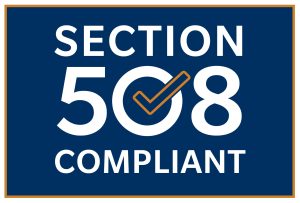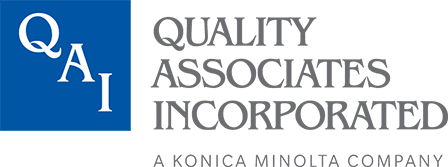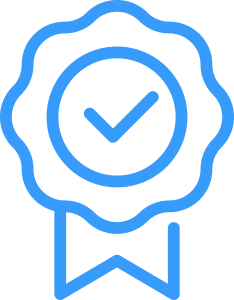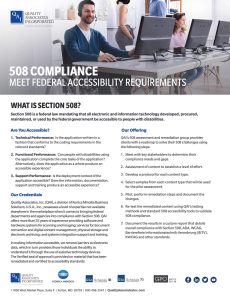
Meet Federal Accessibility Requirements
What is Section 508?
Section 508 refers to a specific portion of the Rehabilitation Act. It sets forth the accessibility requirements pertaining to federal departments and agencies when developing, procuring, maintaining or using electronic and information technology.
Section 508 requires that individuals with disabilities, whether federal employees or members of the public, must be able to access and use data in a manner comparable to individuals without disabilities. Thus, federal agencies operate with a mandate to ensure that everything from software to websites to web applications to hardware applications (computers, networks, peripherals and other types of electronic office equipment) are usable by individuals with disabilities.

Who Benefits From 508 Compliance?
Everyone benefits when all information is accessible to all users. Studies show that user experience optimizations made for accessibility also benefit people without disabilities. Plus, accessible information is more effectively structured, so it is more readily available to search engines. In addition, accessible information is compatible with a wider range of devices.
Are You Accessible?
While accessibility is the central issue for users, the critical question from the federal department/agency is, “Are you compliant?” Asking that question raises three aspects of performance:
- Technical Performance: Is the application written in a fashion that conforms to the coding requirements in the relevant standards?
- Functional Performance: Can people with disabilities using the application complete the core tasks of the application? Alternatively, does the application as a whole produce an accessible experience?
- Support Performance: Is the deployment context of the application accessible? Does the information, documentation, support and training produce an accessible experience?
An application must conform to both the technical and functional requirements in order to be deemed compliant.

Why is QAI Unique in the 508 Arena?
Two factors differentiate us from all other vendors in the 508 arena. Our credentials and our service offering.
Our Credentials
Quality Associates, Inc. (QAI), a division of Konica Minolta Business Solutions, U.S.A., Inc., possesses a level of expertise not available elsewhere in the marketplace when it comes to bringing federal departments and agencies into compliance with Section 508. QAI offers more than 25 years of experience providing software and hardware systems for scanning and imaging; document digitization services,digital content management; physical storage and electronic archiving; and systems integration support and training.
Accessibility defines how individuals with disabilities access electronic information. In making information accessible, we remove barriers to electronic data, which in turn provides those individuals the ability to understand it through the use of assistive technology devices.
Our standard remediation procedures will meet and/or exceed Section 508 compliance standards. QAI uses assistive technology (AT) quality control testers to ensure individuals with disabilities have access to and use of information and data that is comparable to that of persons without disabilities.
The Verified seal of approval is provided on material that has been remediated and certified to accessibility standards. Included in the Verification Process for 508 compliance is the use of visually impaired AT testers during the quality control process. Each team member has the last word on the accessibility of a remediated document, such as a PDF. If approved the document is ready to be delivered to the client. In the rare instance where an accessibility issue remains, the AT tester works directly with the project lead to fix it.
What We Offer
- We will meet with the key stakeholders who manage the content to determine their compliance gaps.
- We will select samples from each content type that will be used for the pilot assessment.
- We will work with your compliance office to assess the content to establish a Level of Effort (LOE).
- We will develop a protocol for each content type and engage QAI’s 508 assessment and remediation group to complete an assessment.
Typical Methodologies
Using the Accessibility Management Platform:
We will assess the current state of systems accessibility compliance and track compliance successes over time, using this integrated set of compliance testing tools. The Accessibility Management Platform offers a variety of features to manage accessibility across the content life cycle, including:
- InFocus — an innovative integrated solution for implementing and monitoring accessibility enhancements for websites and web applications
- Best practices — more than 800 best practices dealing with IT accessibility
- Auditing reports — detailed views of compliance audits, including compliance levels, violations and priorities
- Standards management — manages accessibility development and testing practices across a variety of technology platforms
- Reference library — an extensive collection of reference materials, including consulting methodology, Voluntary Product Accessibility Templates (VPATs) and white papers
Performing System Audits:
QAI uses a process-driven, metrics-oriented, weighted methodology that is specific to identifying the accessibility requirements of IT solutions. This methodology encompasses a range of automated testing, manual testing and data collection procedures, including assistive technology testing, performed by senior technologists with disabilities. The audit process begins with the performance of automatic tests, global tests and manual tests against the user interface modules. These tests determine if the modules are written in a manner that is compliant with the relevant accessibility standards. Then, users with disabilities will perform functional tests using the leading assistive technologies (i.e., JAWS, ZoomText and Dragon) to determine if the overall user experience is accessible.



